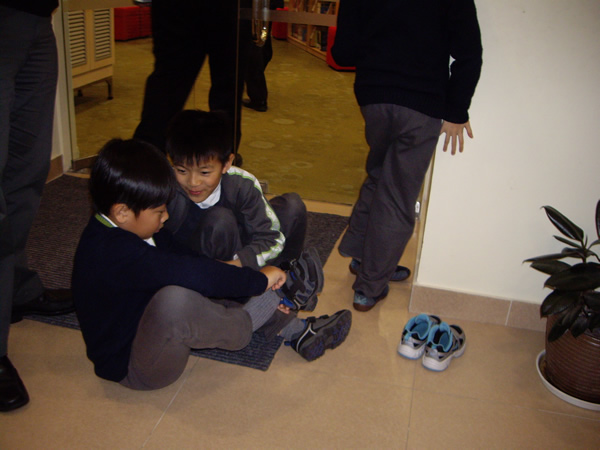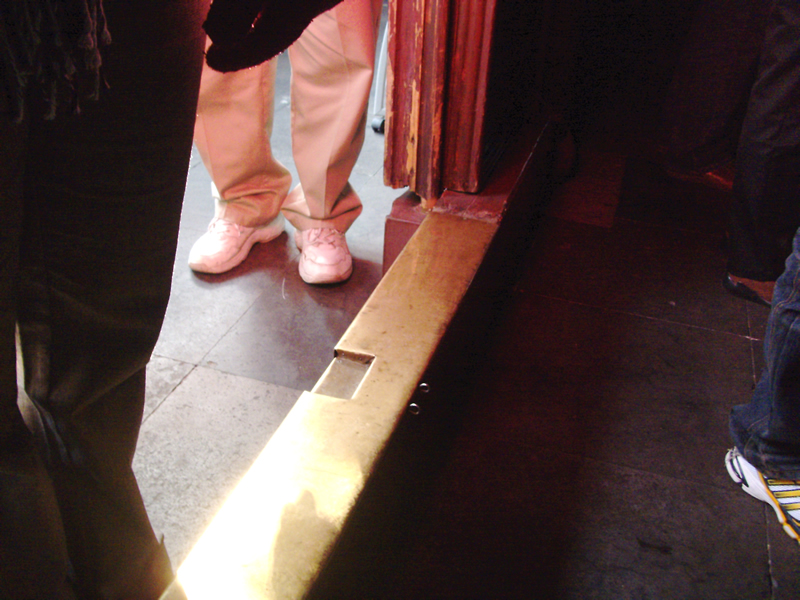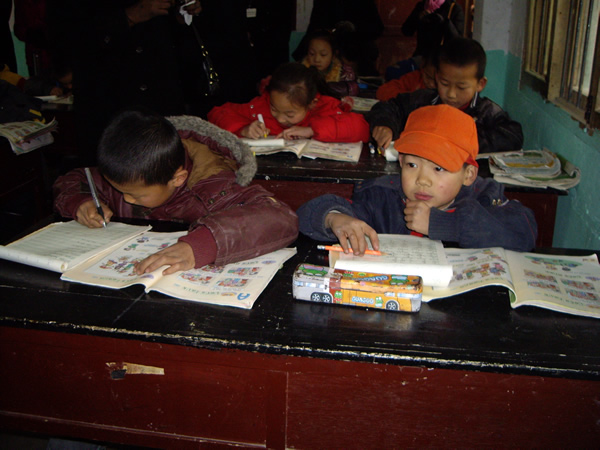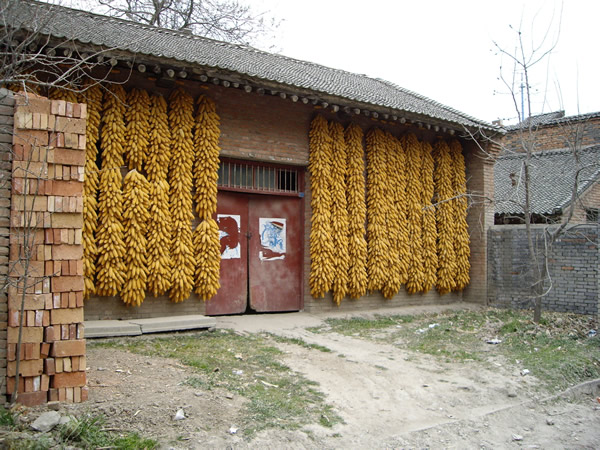Today was our first full day in Shanghai after  arriving yesterday afternoon amid a steady snowstorm. The climate here is supposed to be roughly the same as Jacksonville, Florida, so snow is quite rare. The drivers, already insane in China, proved to be the same as U.S. drivers when winter weather hits. The streets were completely gridlocked, making what should have been a 15 minute bus ride (on a chartered bus used to get us to our city locations) last about an hour and fifteen minutes. We ended up having to cancel our plans to have dinner before an acrobat show. Instead, we ran into take out places right by the acrobat theater. We actually had Chinese take-out in Shanghai; that is we had take out McDonald’s! We had to order by pointing at menu items on the countertop pictures, since the people at the counter did not speak English. The cost was about the same as in the U.S., but the sodas tasted a little different, and the menu offerings were slightly different. In other words, it was about as bad as it is at home. They do manage to make the french fries taste the same. Incidentally, we have been offered french fries at a couple of our otherwise Chinese restaurants. I guess they think this is what all Americans eat. Do you have expectations of what people from another country will want if they visit you?
arriving yesterday afternoon amid a steady snowstorm. The climate here is supposed to be roughly the same as Jacksonville, Florida, so snow is quite rare. The drivers, already insane in China, proved to be the same as U.S. drivers when winter weather hits. The streets were completely gridlocked, making what should have been a 15 minute bus ride (on a chartered bus used to get us to our city locations) last about an hour and fifteen minutes. We ended up having to cancel our plans to have dinner before an acrobat show. Instead, we ran into take out places right by the acrobat theater. We actually had Chinese take-out in Shanghai; that is we had take out McDonald’s! We had to order by pointing at menu items on the countertop pictures, since the people at the counter did not speak English. The cost was about the same as in the U.S., but the sodas tasted a little different, and the menu offerings were slightly different. In other words, it was about as bad as it is at home. They do manage to make the french fries taste the same. Incidentally, we have been offered french fries at a couple of our otherwise Chinese restaurants. I guess they think this is what all Americans eat. Do you have expectations of what people from another country will want if they visit you?
The acrobat show was incredible, but no photos were allowed. There were about 36 acrobats in all, about 2/3 male. They were teenagers who obviously practice very hard and do very scary things. The smallest boy was about the size of an American third grader, and he was always way at the very top of every dangerous stunt. This troupe is reportedly the best in China. I’d love to know more about the history of acrobats in China. Is there any performance that is famous where you live?
 Shanghai is the financial center of China, like Wall Street in New York, and has grown remarkably in the past 20 years. What was farmland on one side of the river that flows through the city is now a farm of skyscrapers, each more impressive than the last. Architects love to design for Shanghai because it is a real showplace for new buildings. The people remind me of New York: very fashion conscious, very busy, and accustomed to crowds. There are 20 million people in this city, and it grows more each year! Young people in China like to move here for job opportunities, but the cost of living is very high. I bought the world’s most expensive bag of cookies this afternoon at a coffee bar similar to Starbucks where we stopped to get warm after walking outside on the Bund (waterfront by the river with a view to the skyscrapers). The bag of 24 small cookies cost $15!
Shanghai is the financial center of China, like Wall Street in New York, and has grown remarkably in the past 20 years. What was farmland on one side of the river that flows through the city is now a farm of skyscrapers, each more impressive than the last. Architects love to design for Shanghai because it is a real showplace for new buildings. The people remind me of New York: very fashion conscious, very busy, and accustomed to crowds. There are 20 million people in this city, and it grows more each year! Young people in China like to move here for job opportunities, but the cost of living is very high. I bought the world’s most expensive bag of cookies this afternoon at a coffee bar similar to Starbucks where we stopped to get warm after walking outside on the Bund (waterfront by the river with a view to the skyscrapers). The bag of 24 small cookies cost $15!
As we travel around in public, we see people stare at us, both because we are a group of almost 40 Americans and because certain ones of us look very different from anyone Chinese. The African Americans cause a sensation because most Chinese have never seen anyone with dark skin. The three of us who are blondes are treated as an oddity, too, sometimes making people stop to take our picture . One of the men in our group is about 6 foot 2 or 3, and some Chinese men at the Xi’an airport ran up to him and pantomimed that they wanted to have their picture taken with him because he is so tall. They then “asked” us (by pantomime) to take their picture with an African American in our group and with our group member who has silver gray hair. We all laughed together even though we could not actually talk to each other. I think the children who swarmed around me in Xi’an did so both because of my blonde hair and because I was American. It is a very funny feeling to be stared at as an oddity, though people are genuinely respectful and cheerful about it.
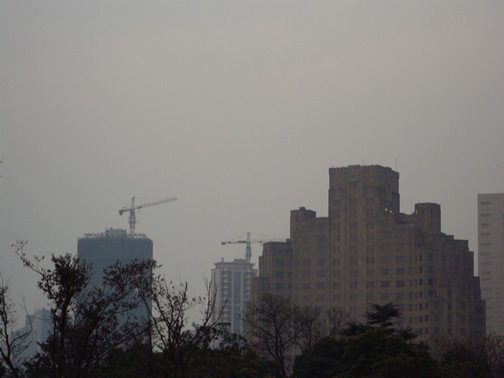 The rate of change in China is unbelievable. We joke that instead of the 1000 paper cranes of Japanese story fame, China has 1000 construction cranes in each city skyline. Our conversations continually underscore the urgency in China to progress and improve, both for as an expectation for students to learn and improve and for progress and change as a society. They are very proud of the way they can implement new ideas or new building projects. They expect changes to be complete very quickly, almost as a two year old asks, “Are we there yet” two minutes after leaving the driveway. The flip side of this urgency is that when they are not sure how to go about making changes, they seek advice on how to “get it done” very quickly. Our group has been asked for advice on making certain changes in education and use of technology during our visits with universities, schools, and national technology centers working with education.
The rate of change in China is unbelievable. We joke that instead of the 1000 paper cranes of Japanese story fame, China has 1000 construction cranes in each city skyline. Our conversations continually underscore the urgency in China to progress and improve, both for as an expectation for students to learn and improve and for progress and change as a society. They are very proud of the way they can implement new ideas or new building projects. They expect changes to be complete very quickly, almost as a two year old asks, “Are we there yet” two minutes after leaving the driveway. The flip side of this urgency is that when they are not sure how to go about making changes, they seek advice on how to “get it done” very quickly. Our group has been asked for advice on making certain changes in education and use of technology during our visits with universities, schools, and national technology centers working with education.
From our perspective, some of the changes they are asking to make will first require some major shifts in the underlying culture and the culture of Chinese education. For example: schools and teaching in China have always been teacher centered, with a teacher at the front of the class talking while students sit and listen. They sit in rows, never making a sound until called upon. They recite aloud as a whole class. They do not do group projects or sit on the floor, except in very unusual, progressive schools who are trying to replicate models from other countries.
Just as educational technology leaders in the U.S. often struggle to get teachers to integrate technology as a learning tool, so do Chinese educational leaders want to see technology put to effective use. But until the teachers have SEEN and understand a different model of teaching, they will have no way to see the role technology might play. Most of the technology use we have seen has still been teacher-centered: projecting a video or PowerPoint show and then asking questions about it for students to stand and respond. Although this happens in the U.S., too, we are far ahead on student technology use as a learning tool. We have invited Chinese leaders from several places to come to the ISTE conference and to learn alongside this professional group in the U.S. If they are as determined as I think they are, I suspect we will see some Chinese folks with us at the annual ISTE conference in Philadelphia next summer.
technology put to effective use. But until the teachers have SEEN and understand a different model of teaching, they will have no way to see the role technology might play. Most of the technology use we have seen has still been teacher-centered: projecting a video or PowerPoint show and then asking questions about it for students to stand and respond. Although this happens in the U.S., too, we are far ahead on student technology use as a learning tool. We have invited Chinese leaders from several places to come to the ISTE conference and to learn alongside this professional group in the U.S. If they are as determined as I think they are, I suspect we will see some Chinese folks with us at the annual ISTE conference in Philadelphia next summer. 
A class left a question on this blog a day or two ago about Chinese number systems, so I asked. The Chinese use both roman numbers (1,2,3,4, etc.) and Chinese characters to represent their numbers, but they use the Roman numbers more. These are easier to print. The characters are more like spelled out numbers or number names. I am including a close up of a bulletin board in a Chinese school (click to see it larger). The math facts should look familiar!
The second bulletin board shot shows science work on the human body in both  English and Chinese (click to enlarge).
English and Chinese (click to enlarge).
Another topic mentioned to us as something the Chinese want to bring into their schools is creativity. But I could write a ton about that. I also need to tell you about the meeting we had at the distance education center here in Shanghai…and many other tales of adventure. We have only one more day here, but I hope to spend some time on the long flight home writing up more about our China experiences. Also to come: Shanghai at night, silk museum, laundry, Shawn– our guide and interpreter, pollution, “there is a policy.” Stay tuned.
 teaching? To reach a consensus of what a good teacher is for this exercise, I would propose using teacher-leaders respected by a broad spectrum of their peers and/or credited by former students as having had profound impact — in both public and private teaching settings. I have some ideas of what they might say, though we know the responses would vary each decade since the 1960s and 1970s, when opportunities for women changed dramatically. Some responses I suspect we would hear:
teaching? To reach a consensus of what a good teacher is for this exercise, I would propose using teacher-leaders respected by a broad spectrum of their peers and/or credited by former students as having had profound impact — in both public and private teaching settings. I have some ideas of what they might say, though we know the responses would vary each decade since the 1960s and 1970s, when opportunities for women changed dramatically. Some responses I suspect we would hear:




